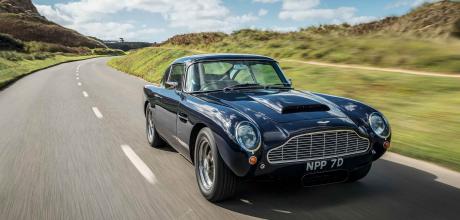1966 Aston Martin DB5 V8
This unique DB5 was created by Aston Martin’s Experimental department as a test-bed for its new V8 engine. Peter Tomalin takes the wheel.
Photography Tim Andrew
EIGHT into FIVE ASTON MARTIN DB5 V8
Period one-off by Aston's Experimental team
This car shouldn’t exist. When it reached the end of its working life as a test mule for Aston Martins nascent V8 engine, it was recorded as being scrapped. Or, as the final hand-written entry in its logbook rather charmingly has it, scraped’. But somehow it escaped the breaker’s yard and, after years spent flying under the radar with a straight-six engine, its significance was recognised and it was restored with a thumping Aston-Martin V8 under the bonnet.
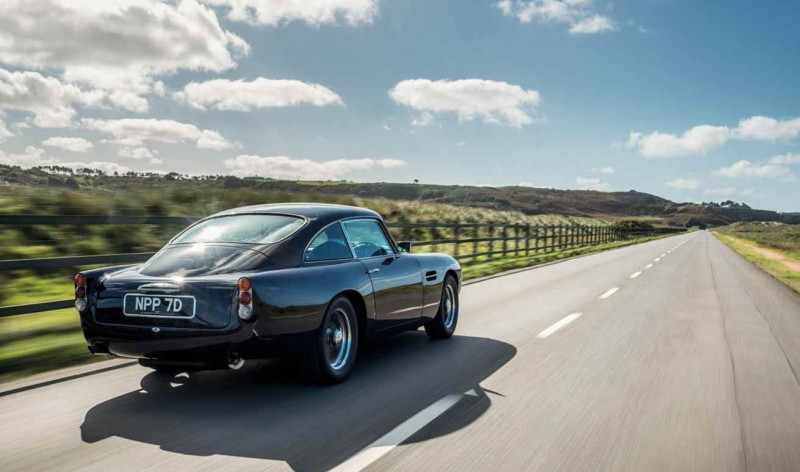
‘It stands testament to the engineers whose dedication ensured the success of the V8 engine’
That was 20 years ago. NPP 7D has spent most of the time since living a quiet life in Jersey, but it’s now back on the UK mainland, where Aston specialist Nicholas Mee & Co has placed it with a new owner who plans to show it at top UK events. And just before it went to its new home it was reunited with one of the men who helped build it and who clocked up thousands of test miles behind its wheel. Bill Bannard was that man, and the stories he can tell about NPP 7D confirm its near-mythical place in Aston history.
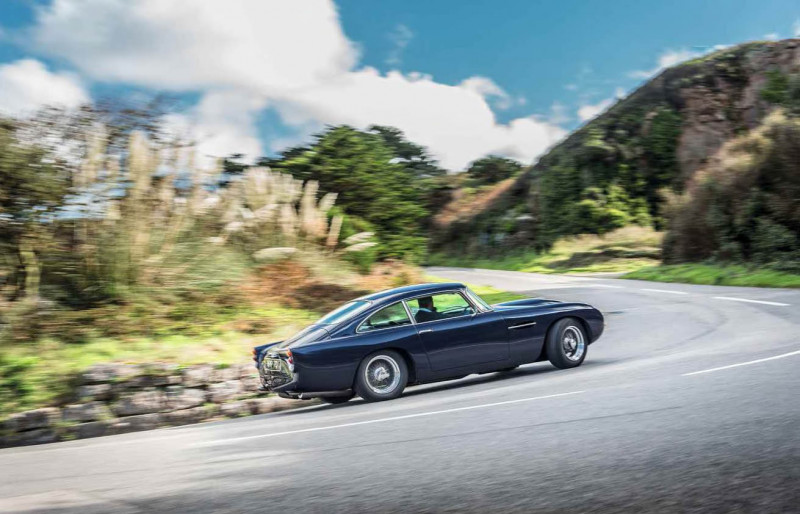
Chassis number 001/D/P was the first prototype to be built at Newport Pagnell after Aston Martin shifted such operations from its old base at Feltham. It was 1966 and the Tadek Marek-designed V8 engine had been in development for a couple of years, though it was plagued with reliability issues. Installing it in a road car and clocking up serious mileage would be a key part of the solution. At the same time, the mule would be used to test a de Dion rear suspension set-up, which Aston intended to replace the live axle that had served since the ’50s. And Bill Bannard, with his colleagues in Experimental, was responsible for developing and building it.
He explained to Nick Mee how they took the platform chassis of a DB6, removed the rear end and created a new one that could take both a live axle and a de Dion set-up, so that they could switch between the two whenever the de Dion needed modifications. According to Bill, the combination of the V8 engine and the live axle was a particularly exciting one. ‘Enormous fun — but lethal!’ was his neat summation.
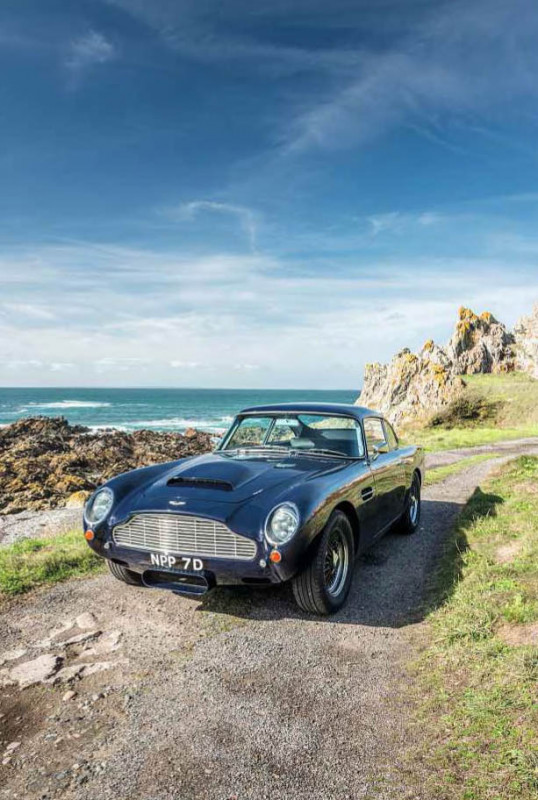
Surplus DBS body panels were extended to fit over the modified DB6 platform — the wheelbase being 4in longer than that of a regular 5, which meant extra metalwork between door and rear wheelarch. Just to further confuse contemporary Aston-spotters, 7D’s original grille was early DB4, presumably for no more noble a reason than that there was one in the workshop. NPP 7D was, in Bill’s words, ‘a real mongrel’. Even so, much thought — and patience — went into squeezing the V8 engine, initially in 4.8-litre form, where the straight-six went. The trickiest part was accommodating the four-into-one exhaust manifolds on each side: with no pipe-bending machine in the factory, each had to be created from welding a number of pre-curved pieces together. Clearances were ‘very, very tight’.
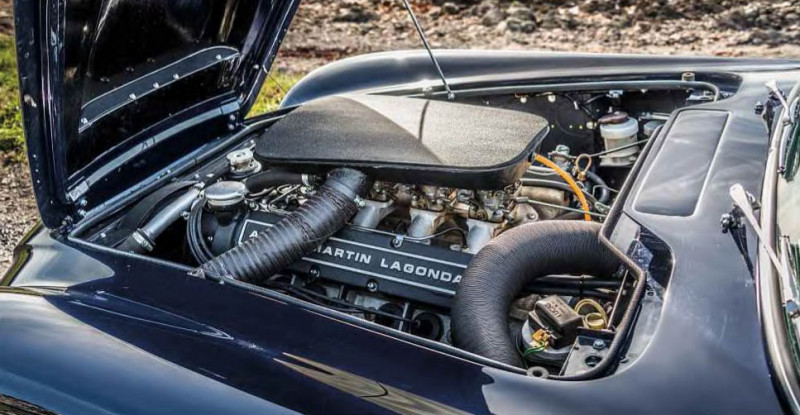
The V8-powered NPP 7D first ran in March 1966, and Bill’s name was first in the logbook, just before that of chief engineer Marek. I had the task of accumulating mileage as quickly as possible, which usually meant 300-350 miles a day,’ says Bill. He would stay within 50 miles or so of the factory in case anything went wrong but would try to avoid using the same roads every day ‘because I was doing a little bit more than the legal speed’.
‘There’s a disconnect between the familiar DB5 surroundings and the V8 soundtrack’
Indeed. The life of a development driver in those pre- speed-camera days was often a game of cat-and-mouse with the local constabulary, and there would have been few faster machines on the A- and B-roads of Northamptonshire and Buckinghamshire than the V8-engined DBS. For the next three years it was used to assess engines of different capacities (4.8, 5.0 and eventually 5.3 litres), Weber carburettors of both IDA and DCOE design (the former necessitating the larger bonnet bulge), and fuel injection systems from both Brico and Bosch. Overseas destinations included Italy and Germany (to visit Bosch).
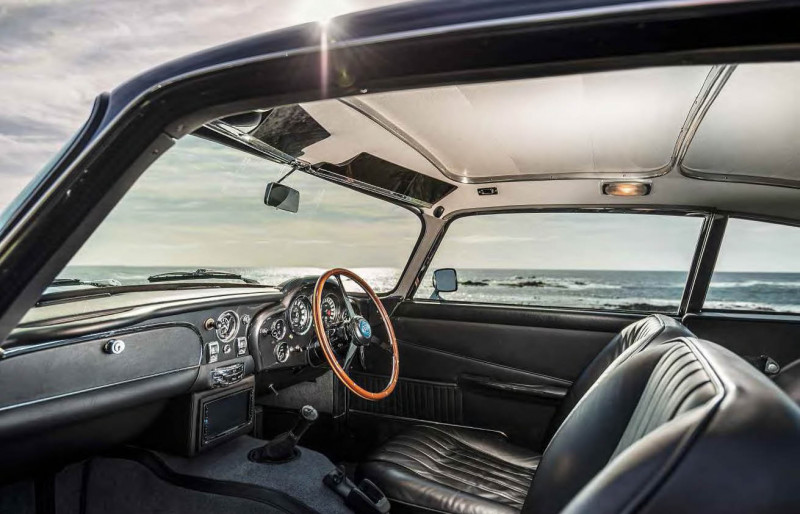
When it was running well, the potential of the V8 was obvious. ‘It was a very nice motor,’ says Bill. ‘Quite docile. It gave 80 or so more horsepower than the six, which meant it could be quite exciting if pushed!’ Apparently it could also chew through a set of Avon Turbospeeds in as little as 3000 miles. The wire spokes were painted rather than chromed, because that made them less likely to break.
The main issue for its roster of drivers, though, was cockpit heat, with limited ventilation, no air-conditioning and considerable heat-soak from the big engine up-front. ‘It was a challenge,’ says Bill, ‘but one advantage was that it stopped people wanting to borrow the car!’
Even when Bill’s focus had moved on to the DBS V8 prototype, he would still occasionally drive 7D. ‘If one had to go somewhere and it was available and you wanted a bit of fun, well, hey, what a nice way to enliven the day!’ The ‘mongrel’ was recorded as being scrapped in January 1969, its work done; the DBS V8 was launched a year later.
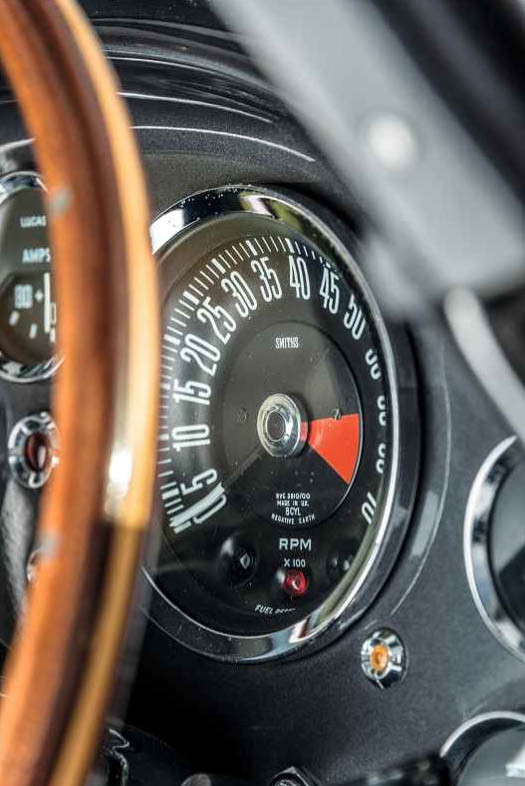
‘Somehow it escaped the breaker’s yard, and after years under the radar its significance was recognised’
When 7D was liberated from Newport Bagnell, it was with a straight-six and live rear axle, but a few years later it landed in the hands of well-known Aston racer David Preece, who with help and advice from Bill Bannard refitted it with a V8 and the original de Dion axle. Preece eventually sold it to Aston specialist RS Williams. In 1999 RSW embarked on a three-year rebuild on behalf of a client, transforming it from rough-and-ready prototype to the pristine machine you see today. Among the changes, beefier 16in wheels were fitted because — with a dyno-measured 352bhp and 402lb ft from the RSW-fettled V8 — it kept breaking its 15in items.
Even if NPP 7D isn’t quite as it was when he knew it, Bill is pleased that it has survived and taken its place in Aston legend. ‘I’m delighted to see the car. It warms my heart to see that it’s being looked after,’ he told Nick Mee. And for all the guys at Newport Pagnell who put a lot of their lives into making cars, that legacy means a lot.’
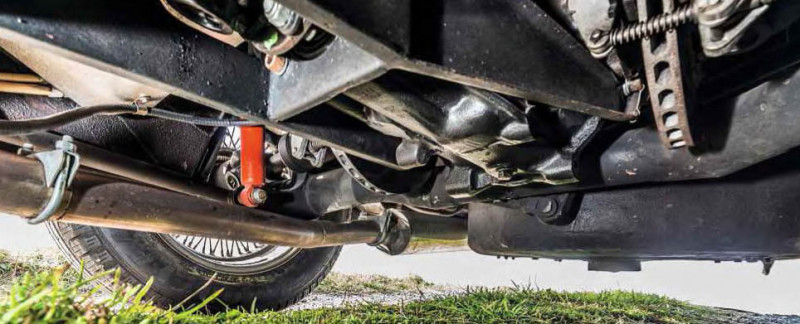
Bill also offers the tantalising thought that the engine and de Dion rear end could have been fitted in later production versions of the DB6. It would have taken more development expense — as we know, Aston Martin was never flush with funds — but what a capable and desirable car that would have been. If only the development of the engine hadn’t been bogged down with teething problems...
So NPP 7D provides a glimpse of what might have been. It also stands testament to the work of a small band of engineers and fitters, whose ingenuity and dedication ensured the eventual success of the V8 engine — and thus Aston Martin’s future. But it’s also just a bloody exciting motor car. As Nick Mee says: ‘The devil in all of us likes a hot rod. This is the DBS that every enthusiast of the marque would like to get behind the wheel of.’
BRYAN WEBB IS the Aston enthusiast who has recently become the new custodian of NPP 7D and he couldn’t be happier. His love affair with Aston began, as so many did, as a youngster with the Bond DBS. ‘My parents had taken my brother and me on holiday to Brighton and it was a rainy Saturday and we went to see Goldfinger. Loved the car, loved the gadgets, and that was it — I was bitten.’
His interest was stoked by childhood visits to Newport Pagnell. ‘Living quite close to Newport Pagnell, we’d go for weekend walks in the Woburn woods and stop off at the factory on the way back, have an ice cream and drip it down the sides of the DB4s and 5s parked outside! One of my most vivid memories is of the splash-marks, the black rings on the walls of Sunnyside [Aston’s building in Tickford Street] where cars had been started up. My brother and I would run between them, peering in at the speedometers, and it would be “This one’s 160” and “This one’s 180! ”

Had they visited on a weekday, they might even have witnessed a certain DBS with a rather unusual exhaust note emerging through the factory gates.
Fast-forward 40 years or so, and in 2012, after a successful career building pipe-making plants around the globe, Bryan found himself in a position to start satisfying his Aston cravings. Since then he’s owned no fewer than 20. These have included a succession of Gaydon-built cars — N430, DB9 GT Bond Edition, V12 DBS, a couple of Rapides — but it’s the Newport Pagnell cars that have always excited him the most He’s owned examples of DB4, 5 and 6, DBS in both six-cylinder and V8 guises (his first Aston was a Persuaders-spec DBS in Bahama Yellow), a brace of ‘Oscar India’ V8s, Vantage X-Pack and Vantage Volante and a super- rare pre-wedge Lagonda series 1. I just love them,’ he grins.
So when he heard that NPP 7D was available, Newport Pagnell to its very core, he had to have it. ‘I’d just missed out on Tadek Marek’s own personal DB4 and then Neal [Garrard] at Nick Mee rang and said “I think we’ve got the ultimate DBS for you.” And when I saw it, it was just like the Scalextric model I’d had as a kid, which I’d taken the bumpers off to make it faster! And of course now I’ve got my own Marek car.’
Bryan shows me a scan of the original log for 7D, kept by Bill Bannard all these years. The hand-written entries are a wonderful record of the car’s life — day by day, who drove it, for how many miles, the petrol and oil consumed, and any problems encountered. Bill features prominently among the drivers, as does Tadek Marek himself, but there are other great names from Aston Martin’s past, including those of engineering directors Dudley Gershon and Mike Loasby, chassis man Harold Beach, even designer William Towns. It’s basically a Who's Who of Aston in the late ’60s.
Since then, only a few lucky souls have been fortunate enough to experience this unique car, Bryan being the latest. And now I’m about to join them.
As you approach NPP 7D it’s very quickly obvious that this is no ordinary DBS, even allowing for the fact that it’s been shorn of its bumpers. The larger bulge in the bonnet is the first thing you notice, that and the bigger wheels and tyres, the wheelarches flared very subtly to contain them at the rear. Then there are the two separate exhausts emerging at each rear corner, rather than the standard single rear box with twin pipes poking out.
It’s the same colour — Pacific Blue — as it was in period, though it was never this shiny then. I can’t help thinking it’d be even more enticing if it looked completely standard DBS, but then, of course, it never was standard’. There are also those extra inches in the wheelbase, not obvious at first, but, once you’ve spotted the increased distance between door and rear wheelarch, impossible to unseen.
Now lift the bonnet and gaze in wonder. It really is very tight in there, the manifolds right up against the cut-away inner wings, while the airbox for the four downdraught Weber DCNF carburettors almost touches the underside of the bonnet. But fit it does — and when it fires and you blip the throttle, the whole car rocks with torque.
Inside, the only tell-tale as you settle into the driver’s seat is the greater protrusion of the transmission tunnel into the footwell; otherwise it’s classic DBS save for the dog-leg first on the slightly later ZF five-speed gearbox and the ‘8-cyl’ mark on the rev-counter, redlined at 6000. Oh, and the speedo, reading all the way to 200mph. The schoolboy Bryan would have adored that; the grown-up one thinks it’s pretty cool too.
As with any DB-era Aston, all the major controls are pretty weighty, the unassisted steering formidably so at low speeds, exacerbated by the substantial footprint of the 215/65 Pirellis, requiring you to haul at the skinny-rimmed wheel. Mercifully, once you’re above jogging pace it’s merely heavy. The clutch takes up progressively and you’re under way with just a tickle of revs.
There’s clearly a disconnect between the familiar DBS surroundings and the burbling soundtrack. It’s classic V8, a bigger, breathier, more sonorous note pulsing from those twin pipes. Less busy-sounding than the six, more muscular. Which is exactly how the whole car feels, too.
Bill Bannard reckons that, back in the day with the 5.0-litre engine, 7D ran out of puff in the 140s ‘because we never really developed the intake system’, while David Preece has said that he clocked 145mph when he raced the car in the ’80s. With this extremely fit-feeling RS Williams engine, something in the region of 160mph is theoretically possible, although as Bill has spoken of noticeable front-end lift at 140mph, it might be quite the white-knuckle ride to get there.
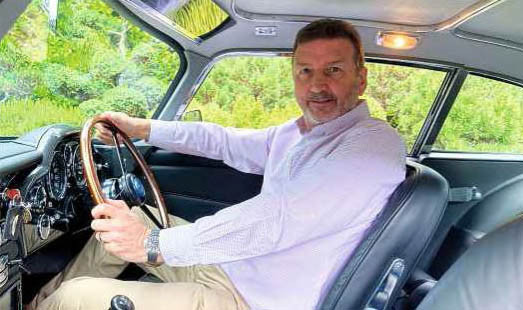
Not that we’ll find out today on these narrow lanes. What I can tell you is that NPP 7D feels substantially quicker than any standard six-cylinder DBS or 6; the torquey nature of the V8 makes accessing the power so much easier. In any gear and at any revs, a squeeze of the throttle is rewarded instantly with a solid shove of acceleration. Hold it in gear and the rush keeps coming, the exhaust note flattening and compressing. I keep the driver’s side window down, all the better to hear its crescendo — and introduce a welcome breeze to the cabin.
It’s long-legged, too, third gear being good for anything from ISmph to well past the legal limit, so on back-roads like these you find yourself rowing between second and third — on the same plane thanks to the dog-leg first. Responses to steering inputs feel similar to those of a regular DBS, the extra few kilos of the V8 countered by the wider tyres. The ride is on the firm side but rarely does it jar. And while it’s hardly a definitive test, the de Dion rear end feels a good deal more composed under power, less susceptible to being upset by bumps and potholes, less inclined to judder and shimmy than a live-axle equivalent.
It all just works, quite beautifully. Even mooching through town, the V8 is completely untemperamental, and the whole car feels tight and together, testament to the quality of the RS Williams restoration. The hot rod has been civilised, but it’s still a compelling proposition.
In fact, it occurs to me that it’s rather like driving all of Newport Pagnell’s greatest hits in one car: DBS body, DB6 chassis but with the de Dion rear end from the DBS, and of course the engine from the DBS V8. A mongrel then, but an immensely likeable one, and it’s been such a privilege to make its acquaintance.
THANKS TO Bryan Webb and Nicholas Mee & Co, nicholasmee.co.uk.
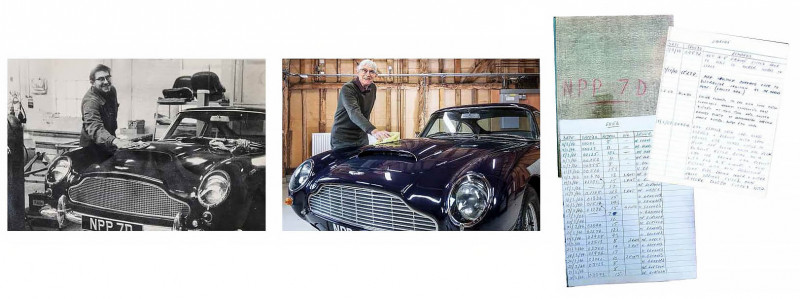
Above Current owner Bryan Webb is a lifelong Aston Martin aficionado, following Goldfinger - and many a childhood visit to Newport Bagnell.
Above and facing pageLonger wheelbase dictated changes to DB5 bodywork; rear de Dion set-up was interchangeable with the original live axle; VS in place of the straight-six; dog-leg first gear is a clue.
Clockwise, from above Special ‘8-cyl’ rev-counter is matched with 200mph speedometer; few other give-aways in DB5's businesslike cockpit; stretching its rather longer legs on the open road.
TECHNICAL DATA 1966 Aston Martin DB5 V8
- Engine 5340cc V8, DOHC per bank, four Weber DCNF carburettors
- Max Power 352bhp @ 5500rpm
- Max Torque 402lb ft @ 3500rpm
- Transmission Five-speed manual, rear-wheel drive, limited-slip differential
- Steering Rack and pinion
- Suspension Front: double wishbones, coil springs, telescopic dampers, anti-roll bar. Rear: de Dion axle, trailing arms, Watt's linkage, coil springs, telescopic dampers
- Brakes Discs
- Weight 1500kg (est)
- Top speed 160mph (est)
- 0-60mph 7.0sec (est)
Clockwise, from left V8-powered DB5 mule is a taste of what might have been; engineer and test driver Bill Bannard then and now; NPP 7D's hand-written log is a priceless record of its career.


